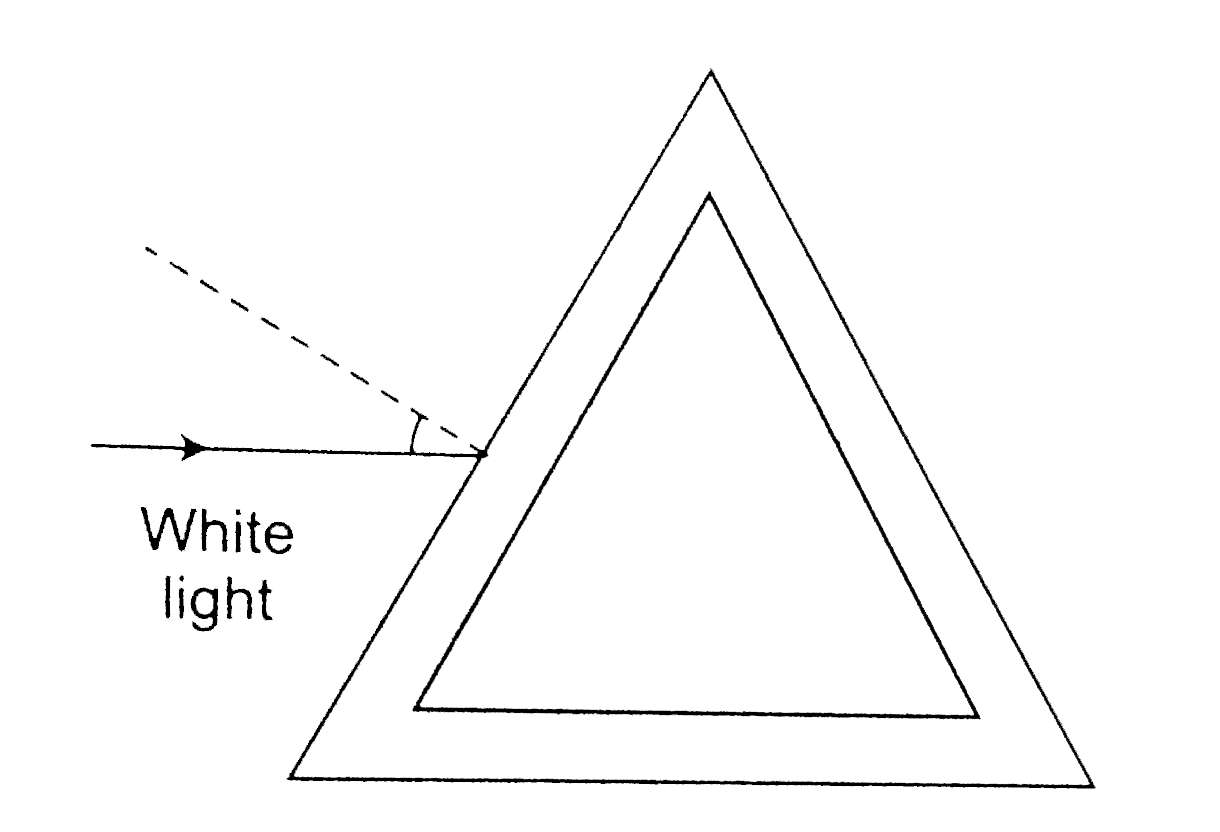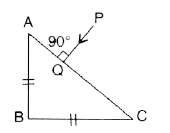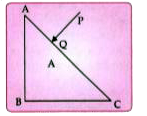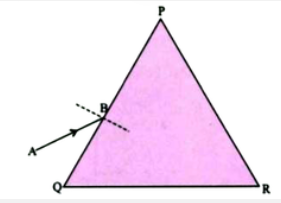A beam of white light is incident normally on the surface AB of an equilateral prism ABC and emerges out of it suffering a deviation of 60∘.
(a) Draw a diagram to show the path of beam till it emerges out of the prism. Mark the angles wherever necessary.
(b) What assumption have you made while drawing the diagram ?
(c) Name the phenomenon exhibited by the light beam.
Step-by-Step Solution
1. Draw the Prism: Start by sketching an equilateral triangle to represent the prism ABC, where points A, B, and C are the vertices of the triangle.
2. Incident Ray: Draw a straight line representing the beam of white light incident normally on the surface AB. Since it is normal incidence, the angle of incidence (i) is 0 degrees.
3. Normal Line: At point B, draw a dashed line perpendicular to the surface AB to represent the normal line.
4. Path Inside the Prism: Since the light is incident normally, it will pass through the prism without any deviation at this surface. Draw a line from point B to point C, indicating the path of the light inside the prism.
5. Angle of Incidence at AC: At point C, draw the normal line to surface AC and mark the angle of incidence as 60 degrees (this is given in the problem).
6. Refraction at AC: Draw the refracted ray that emerges from surface AC. Since the problem states that the light beam suffers a deviation of 60 degrees, indicate this deviation in your diagram.
7. Label the Angles: Clearly label the angles of incidence and the angle of deviation in the diagram.
8. Final Diagram: Your final diagram should show the incident ray, the path through the prism, and the emergent ray, along with the angles marked.
(b) Assumptions Made While Drawing the Diagram
1. Critical Angle: It is assumed that the critical angle for the glass-air interface is less than 60 degrees. This allows for total internal reflection to occur at surface AC.
2. White Light Composition: The assumption is made that the beam of white light consists of various colors, but it is treated as a single beam for the purpose of this question.
3. Normal Incidence: It is assumed that the beam is incident normally on surface AB, which means it does not undergo any deviation at this surface.
(c) Phenomenon Exhibited by the Light Beam
The phenomenon exhibited by the light beam is Total Internal Reflection. This occurs when the light beam strikes the boundary between two media (in this case, glass and air) at an angle greater than the critical angle, causing it to reflect back into the medium rather than refracting out.
---
Topper's Solved these Questions
- BOOK - ICSECHAPTER - SPECTRUMEXERCISE - EXERCISE A40videos
SPECTRUM
- BOOK - ICSECHAPTER - SPECTRUMEXERCISE - EXERCISE A (MULTIPLE CHOICE TYPE)6videos
SPECTRUM
- BOOK - ICSECHAPTER - SPECIMEN QUESTION PAPEREXERCISE - QUESTIONS33videos
SPECIMEN QUESTION PAPER
- BOOK - ICSECHAPTER - WORK,POWER AND ENERGY EXERCISE - DIAGRAM BASED MCQ3videos
WORK,POWER AND ENERGY
Similar Questions
A beam of white light is incident on a hollow prism of glass. Then
 View Solution
View SolutionA ray of light falls normally on a rectangular glass slab.
Draw a ray diagram showing the path of the ray till it emerges out of the slab.View SolutionA ray of light PQ is incident normally on the hypotenuse of a right angled prism ABC as shown in the diagram given below:
Copy the diagram and complete the path of the ray PQ till it emerges from the prism.View SolutionIn figure, a ray of light PQ is incident normally on the hypotenuse of an isosceles right angled prism ABC. (a) complete the path of the ray PQ till it emerges from the prism. Mark in the diagram the angle wherever necessary. (b) what is the angle of deviation of the ray PQ ?
(c) Name a device in which this action is used.
 View Solution
View SolutionA beam of monochromatic light is incident at i=50∘ on one face of an equilateral prism, the angle of emergence is 40∘, then the angle of minimum deviation is :
View SolutionFigure below shows a light ray of green colour incident on the prisms A,B and C. in each case, draw the path of the ray of light as it enters and emergest out of the prism. Mark the angle wherever necessary.
 View Solution
View SolutionA ray of light falls normally on a glass slab. Draw a diagram showing the path of the ray till it emerges out of the slab. What is the angle of incidence and angle of refraction at each surface of slab ?
View SolutionA ray LM of monochromatic light incident normally on one refracting surface AB of a regular glass prism ABC emerges in air from the adjacent surface C as shown in figure. Calculate the refractive index of the material of the prism.
View SolutionA ray of light PQ is incident normally on the hypotenuse of a right angled prism ABC as shown in the diagram given below:
What is the value of the angle of deviation of the ray ?
 View Solution
View SolutionComplete the path of the monochromatic light ray AB incident on the surface PQ of the equilateral glass prism PQR till it emerges out of the prism due to refraction.
 View Solution
View Solution

